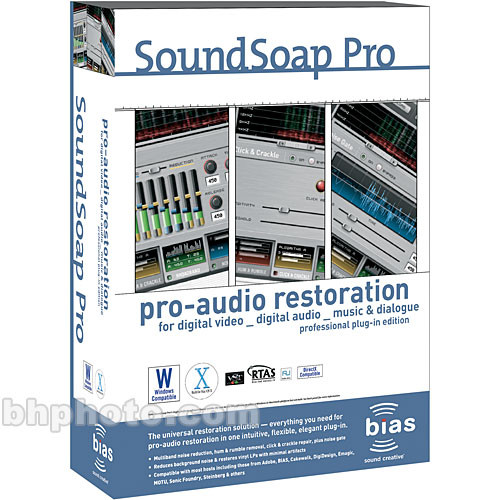

Intermittent noises appear infrequently and may not be consistent in pitch or duration.
SOUNDSOAP DECLIPPER MANUAL
Most audio restoration products include both automatic and manual tools for removing clicks and pops.Ĭlipping is a common problem that occurs when a loud signal distorts on input to a sound card/converter, mixing console, field recorder or other piece of equipment. Addition examples can be heating, ventilation, and air condition systems, as well as DV camera motor or needle hiss.Ĭlicks and pops are common on recordings made from vinyl and can also be introduced by digital errors, including recording into a DAW with improper buffer settings. Tape hiss and noise ventilation systems are good examples of broadband noise. Unlike hum and buzz, broadband noise is spread throughout the frequency spectrum and not concentrated at specific frequencies.
SOUNDSOAP DECLIPPER SOFTWARE
Software can suppress some of the harmonics. It only takes a few harmonics to create a hum or buzz. Hum is usually the result of electrical noise somewhere in recorded signal chain heard as a low frequency tone based between 50Hz or 60Hz. #149 Putting analog tapes or vinyl onto CDs.īefore reviewing the audio restoration software applications, let’s look at some of the audio problems frequently found in recordings. #149 Restoring old recordings removing unwanted noise. At the URL above, check out the WWII recording of a heavily clipped recording that was salvaged. (You can’t remove clipping, but you can use click/crackle repair to minimize it. #149 Cleaning up a phone interview clipping. #149 Removing clicks and pops from a concert on record. #149 Restoring an Historical Speech making voice more intelligible. #149 Using EQ and other tools with the spoken word. #149 Removing Broadband Noise from a concert recording. There are 19 before-and-after recording examples to listen to help illustrate this process for you at A list of recording challenges that new audio restoration software can correct include: It can also enhance the audio quality of the original recording. “Audio restoration” is a generalized term for the process of removing imperfections (such as hiss, crackle, noise, and buzz) from sound recordings. While the recording industry has traditionally dealt with audio restoration, music educators have not because it was complicated and cost prohibitive. Now just as dramatic results are available to everyday music educators with audio archives and performances we want to share via Internet blogs, podcasts, Web postings, CDs, and DVDs. We are all familiar with those dramatic “before and after” weight loss ads. Please Click Here to Support SBO Magazine! We hope you continue to remain healthy during this most strenuous of times.

We at School Band & Orchestra wish nothing but the best for you, your school, your family and co-workers. Your consideration is greatly appreciated. It is with the utmost sincerity we ask you to consider supporting our efforts here with a small donation which will allow our staff the ability to keep these interesting stories about your chosen career coming to you in a consistent and timely basis. However, we would like your consideration in these difficult times to help support our efforts here at School Band & Orchestra to keep our information flowing and to provide you with a continuous stream of current and vital information when you need it the most.
SOUNDSOAP DECLIPPER FOR FREE
We have been proud to bring School Band & Orchestra for free for more than two decades and we will continue to provide you with free subscriptions during the pandemic. We certainly understand times are tough for you, as it is for us. It is a strange and trying time for all of us in the midst of the COVID-19 pandemic.


 0 kommentar(er)
0 kommentar(er)
